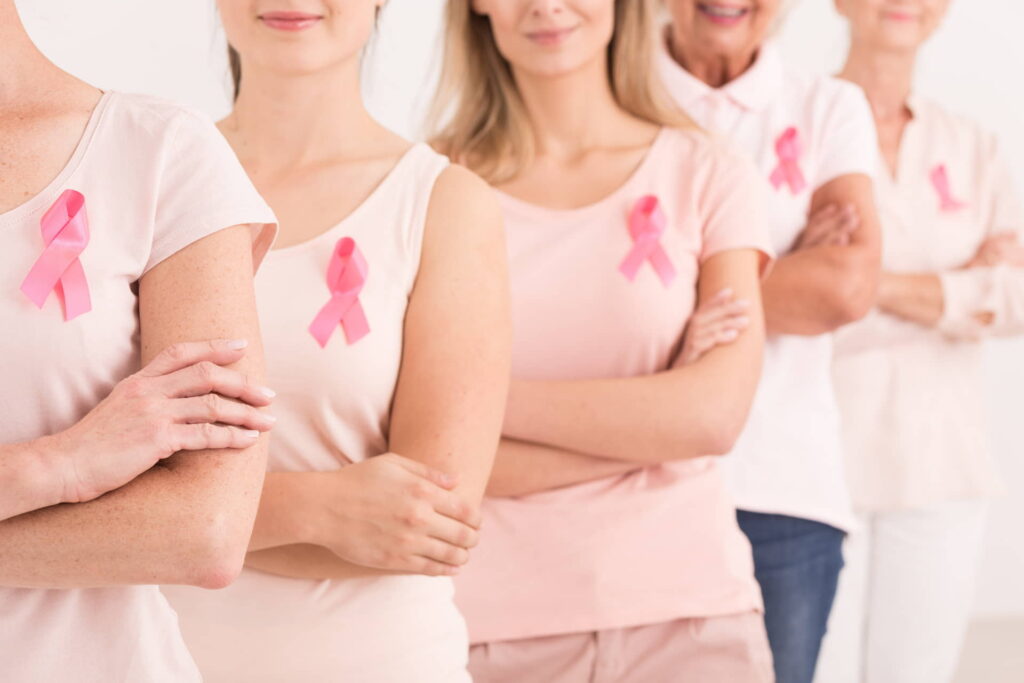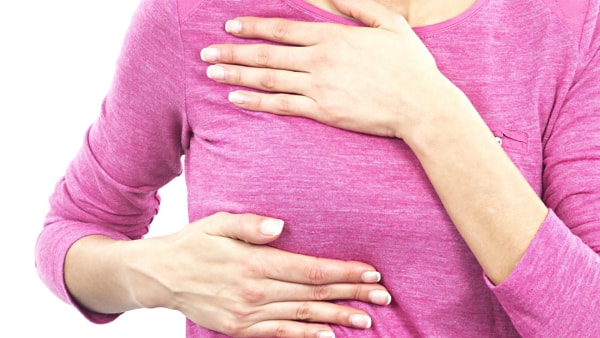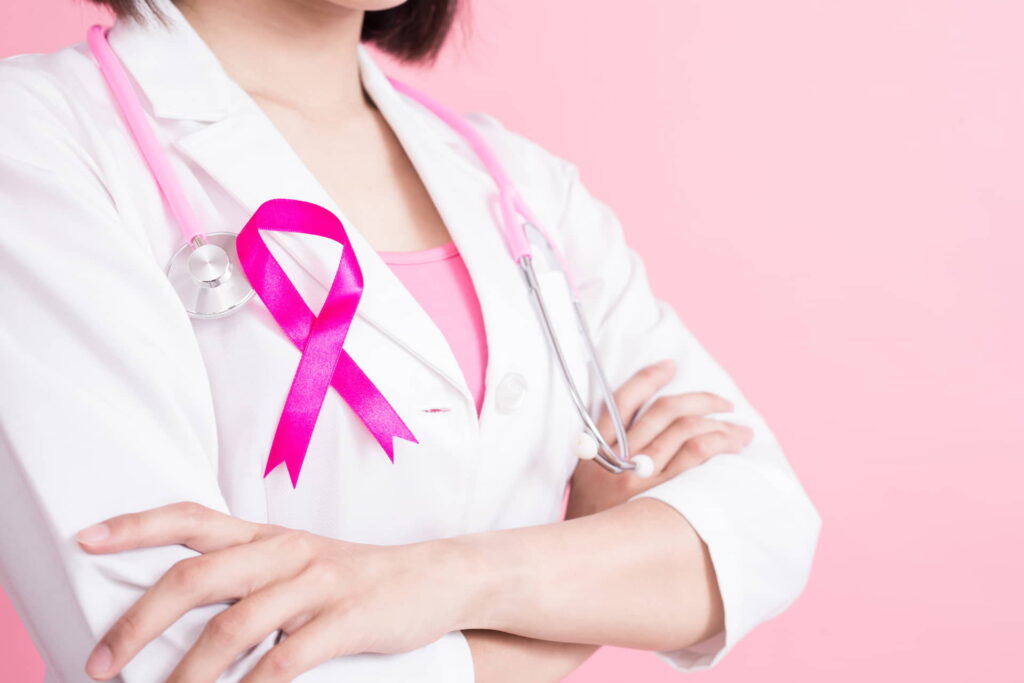
Breast Cancer
Understanding the causes, treatment and prevention of breast cancer and breast cancer rehabilitation care to improve survival rates
Breast cancer (also known as mammary cancer) is the third deadliest cancer and the most common tumor among females in Hong Kong. The causes of breast cancer are related to lifestyles, reproductive factors, personal and family medical history. Breast cancer is usually asymptomatic and is not felt until the tumor has grown into a significant lump and proliferated. Regular check-ups which are effective in preventing and detecting symptoms of breast cancer can help patients receive immediate treatment, significantly raising their survival rate.
It is estimated that 1 in every 14 women in Hong Kong may develop breast cancer in her life. Similar to other cancers, breast cancer is characterized by the uncontrolled proliferation of abnormal cells which destroys healthy tissues and spreads into other organs. The cancer cells of breast cancer may attack breast tissues, and metastasize to the lymph glands in the armpits and other organs of the body such as lungs, bones, the liver and even the brain, which impairs the function of the affected organs and threaten the patient’s life. Yet, early detection of symptoms and treatment can not only reduce medical expenses, but also avoid unnecessary treatment and its adverse effects on the body and mind.

According to an analysis by the Hong Kong Cancer Registry (HKCaR), as of 2019, the survival statistics of breast cancer patients between 2010 and 2017 showed that 84.0% of breast cancer patients were able to survive for more than five years compared to the general population. The five-year relative survival rates for breast cancer were 99.3% for stage I, 94.6% for stage II, 76.2% for stage III, and 29.8% for stage IV.
Symptoms of Breast Cancer
- Breast lumps: changes in shape or size
- Breast skin changes or deformities: Thickened or scaly skin
- Nipples in sunken position or with ‘orange peel skin’
- Discharge of fluid or bleeding from nipples
- Swollen armpits or lymph nodes
- Breast pain
Women may occasionally feel swelling or pain in their breasts, or hard lumps in their nipples due to the hormone changes during menstruation or early pregnancy, which are normal physiological reactions. Breast cancer is usually asymptomatic when the tumor is small and curable, and it is only noticeable when the tumor has grown into a significant lump and proliferated. Patients with suspicious symptoms should seek medical attention as soon as possible to determine whether the tumor is benign or malignant. However, most breast lumps, such as hygroma or benign fibroma, are benign and harmless to the body. Causes of Breast Cancer
Causes of Breast Cancer
Breast cancer is closely related to certain high-risk factors that may increase the chance of developing breast cancer.
- Lifestyles: lack of exercise, stress, excessive consumption of high-fat foods and red meat, frequent overnight work, smoking and drinking
- Reproductive factors: no experience of breastfeeding and pregnancy, first pregnancy after the age of 35, menarche before the age of 12, menopause after the age of 55, the experience of hormone replacement therapy
- Personal medical history: obesity, family history of breast cancer, family members or individual previously diagnosed with breast cancer, the experience of breast biopsy, presence of abnormal cells in aspiration, lobular carcinoma in situ, intraductal papilloma
Breast Cancer Screening
- Self-examination
Women over the age of 20 are advised to self-examine their breasts regularly every month to understand their breast condition and observe any abnormal changes. Women of childbearing age can have a check-up 2-3 days after their menstruation cycle every month. Women in menopause can self-examine on the first day of each month for easy referencing. Observe any dimpling, redness or other colour changes in the breast skin, and any abnormalities, shape and colour changes, bleeding or discharge of fluid in the nipples.
Procedures of self-examination:
- Stand in front of a mirror, take off your clothes and raise your arms over your head to look for any abnormalities in the breasts.
- Gently massage the inner side of your breasts in circling movements to check for any lumps.
- Repeat the procedure on the outer side of your breasts.
- Examine the area between the breasts and the armpits for any lumps.
- Gently squeeze the nipples and look for any discharge of fluid or blood.

- Clinical examination
Patients should, considering their age and family medical history, receive regular breast examinations, including assessment and palpation by medical professionals to better identify breast diseases.
Diagnosis of Breast Cancer
After reviewing the medical history, the doctor will first examine the lymph nodes in the breasts, armpits, and neck to detect any swelling, pain or other abnormalities. The doctor will then conduct a series of tests to make proper suggestions based on the patient’s age, symptoms, clinical findings and the risk of having breast cancer.
Preliminary Tests
If the blood sample contains a chemical substance which are necessary for the growth of cancer cells, it may indicate the presence of cancer cells in the body.
Radiographic test can effectively detect early-stage breast cancer with no tumor or impalpable tumor. Your breast will be placed on an X-ray scanner. The plastic sheets of the machine will move vertically and horizontally to fasten the breast to take a mammogram of the breast tissues.
Ultrasound scan is a safe and painless screening procedure. A probe will emit high-frequency sound waves to the breast tissues, and then collects the sounds that bounce back. The sound waves will be converted into images to examine the condition inside the breast. It is also used to assist radiography in identifying whether the lump is a hard mass or a cyst.
Pathology tests
- Surgical Biopsy
- Excisional Biopsy
Excisional biopsy provides the highest accuracy, but it is a relatively invasive procedure. The doctor will make an incision of 1 to 2 inches on the patient’s breast to remove the entire tumor and the nearby area, and perform follow-up observation.
- Needle Biopsy
- Fine Needle Aspiration (FNA)
- Core Needle Biopsy (CNB)
A thin needle is inserted into the breast to withdraw tissues for laboratory tests. If a benign cyst is identified during the ultrasound scan, the fluid in the cyst can also be removed using FNA.
CNB has a similar procedure to that of FNA, but a higher accuracy since it uses a thicker needle to obtain sufficient breast tissue for cytology tests. If the biopsy result indicates the presence of cancer cells, further hormone receptor test and the HER2 test are required to determine the appropriate method of treatment.
Doctors may suggest patients undergo more tests to identify the size, location and spread of tumors, which helps doctors decide the stage of breast cancer and the treatment method.
Survival Rate of Breast Cancer

Treatment of Breast Cancer
Breast cancer treatment can be divided into three categories: surgery, radiotherapy, and medical therapy.
- Surgeries
- Lumpectomy
- Mastectomy
- Breast reconstruction
This method is suitable for patients whose tumor covers only a small area of the breast. The surgeon will remove the tumor and some of the surrounding lymph nodes.The surgery will leave a scar, of which the size depends on the location and the size of the tumour.
In cases of large tumors or scattered cancer cells, the doctor will remove the entire breast, and even the lymph nodes in the armpits and part of the chest muscle. Patients may wish to receive breast reconstruction after the mastectomy.
Patients can opt for breast reconstruction to maintain the appearance of the breast after surgery. Two main types of breast reconstruction surgeries are breast implants and flap reconstruction. Breast implants involve saline or silicone implants, while flap reconstruction uses the patient’s body tissue such as the skin and fat from the abdomen or buttocks to rebuild the breast.
- Radiotherapy
Radiotherapy uses high-energy ray beams to target and kill the cancer cells.Radiotherapy is commonly adopted to remove any remaining cancer cells after the surgery to reduce the risk of recurrence. When breast cancer reaches an advanced stage where the tumor is too large and vascular proliferation causes bleeding, radiotherapy can also be used as a palliative treatment to effectively stop bleeding.
- Medical therapies
- Chemotherapy
- Hormone Therapy
- Targeted Therapy
Chemotherapy, also known as ‘Chemo, uses an intravenous injection to inject cytotoxic drugs through the bloodstream to destroy cancer cells. Chemotherapy was used for early-stage breast cancer as post-operative adjuvant therapy to reduce the chance of recurrence. In recent years, it has been found that some breast cancer patients, especially those with HER2 gene and triple-negative breast cancer, can be treated with chemotherapy before surgery (an additional targeted therapy should be conducted in case of HER2 gene). The tumor size can be reduced in advance, which facilitates the following surgery and gives a better chance of preserving the breast
Hormone therapy lowers the levels of the female hormone to block the growth of cancer cells. Patients will take pills which stop the production of hormones to prevent hormones from binding to cancer cells. Patients can also choose to remove their ovaries or receive radiotherapy to stop the production of oestrogens, reducing the risk of recurrence.
Targeted therapy targets the growth factors of certain cancer cells to prevent their growth and repair. HER2 inhibitors are the earliest invented targeted therapy drugs among various cancer treatments and have been used since as early as 2000. It is generally used in advanced breast cancer to control tumor growth, or in early-stage breast cancer as post-operative adjuvant therapy. In recent years, it has been found that breast cancer patients with the HER2 gene can be treated with chemotherapy and targeted therapy drugs before surgery to reduce the size of the tumor for a better chance of preserving the breast in the surgery.
In addition, for advanced HER2-positive breast cancer, there is a new generation of antibody-drug conjugates (ADC), which is a chemotherapy drug that can identify HER2 receptors. The drug can facilitate precise treatment by precisely adhering to the HER2 cancer cells, and entering the nucleus before releasing a high dosage, thus reducing the side effects on healthy cells.

Recovery and Rehabilitation of Breast Cancer
After receiving various treatments, breast cancer patients should have regular follow-up consultations and check-ups to inform doctors of their recovery progress. If symptoms such as bone pain, shortness of breath or limb numbness persist, patients should seek immediate medical attention. In addition, patients should follow the doctor's instructions to carry out simple arm exercises to keep the joints flexible and reduce swelling, and avoid lifting heavy objects to prevent arm injury that slows down the recovery.
Prevention of Breast Cancer
There is no certain way to prevent breast cancer, but scientific research has confirmed that some important factors related to breast cancer can reduce the risk of cancer and its recurrence.
- Healthy Lifestyle
Relieve stress, exercise moderately, refrain from smoking
- Weight control
Maintain a healthy diet, drink less alcohol, consume less saturated animal fat and more vegetables
- Regular women’s health checks
Have regular check-ups to identify illnesses and abnormal conditions of body functions as soon as possible, and to take follow-up actions for effective prevention.
Breast Cancer FAQ
Should I receive breast cancer screening during COVID-19?
Many people have missed their mammogram appointments because of the pandemic. If you are going to have a mammogram, please seek medical help. If you have any symptoms of breast cancer, contact your doctor immediately. Receiving a regular mammogram is the best way to detect breast cancer in its early stage.
Please note that if you have received COVID-19 vaccination, and want to receive a breast screening, you should avoid conducting the screening within 4-6 weeks after the vaccination. Otherwise, you may have swollen lymph nodes that may lead to misinterpretation of the mammogram. However, if you suspect that you have a breast tumor, such as feeling a hard lump, you should schedule a mammogram as soon as possible, regardless of the circumstances.
Will frequent hair colouring increase the chance of breast cancer?
Researchers have long been studying the possible link between hair dyes and cancer, but the results have been inconsistent. A recent study published in 2019 by the National Institutes of Health suggests that the risk of having breast cancer increases with the more frequent use of chemical hair care products. The study found that women who used permanent hair dyes and chemical hair straightening products had a higher risk of having breast cancer than women who did not.
Can breastfeeding reduce the risk of breast cancer?
Breastfeeding can reduce the risk of breast cancer.



